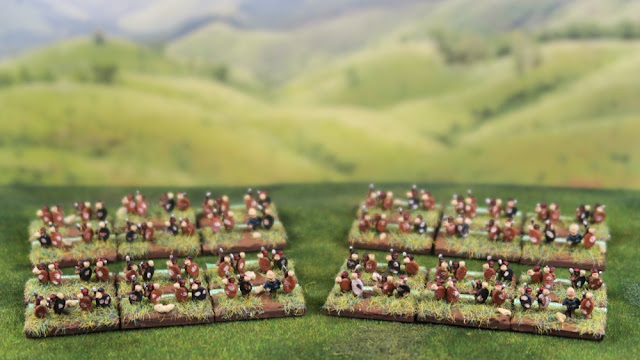During this years Painting Challenge I am not focusing on just one army or new project. Instead I decided I would revisit some of my older armies and finally get around to adding to them like I have been saying I would for ages. The first of these additions are four of companies of Natal Native Contingent to support the British Infantry I painted in the Challenge last year.
The NNC were an Auxiliary force of mostly Basuto and Mponso troops who were recruited to fight alongside the colonial regulars. They were generally organised along the same lines as the British troops with companies of about 100 warriors with 6 NCO's and three Officers per company. They were not issued with uniform and were only distinguishable from their Zulu opponents by a red bandanna worn around their heads. Fears about arming native warriors (even allies) meant that only one in ten were issued with a rifle.
Some Imperial officers (such as Colonel Durnford, who died at Isandlwana) believed the NNC should have been used as scouts and light infantry. Less wise heads however decided these troops were only good for menial labour, believing their fighting ability was negligible. Sadly they remained poorly lead and ill used throughout the war against the Zulu's and not surprisingly their performance in battle reflected this. At Isandlwana for instance they fought hard but in the end died alongside their better armed white comrades.
The NNC were an Auxiliary force of mostly Basuto and Mponso troops who were recruited to fight alongside the colonial regulars. They were generally organised along the same lines as the British troops with companies of about 100 warriors with 6 NCO's and three Officers per company. They were not issued with uniform and were only distinguishable from their Zulu opponents by a red bandanna worn around their heads. Fears about arming native warriors (even allies) meant that only one in ten were issued with a rifle.
Some Imperial officers (such as Colonel Durnford, who died at Isandlwana) believed the NNC should have been used as scouts and light infantry. Less wise heads however decided these troops were only good for menial labour, believing their fighting ability was negligible. Sadly they remained poorly lead and ill used throughout the war against the Zulu's and not surprisingly their performance in battle reflected this. At Isandlwana for instance they fought hard but in the end died alongside their better armed white comrades.


















